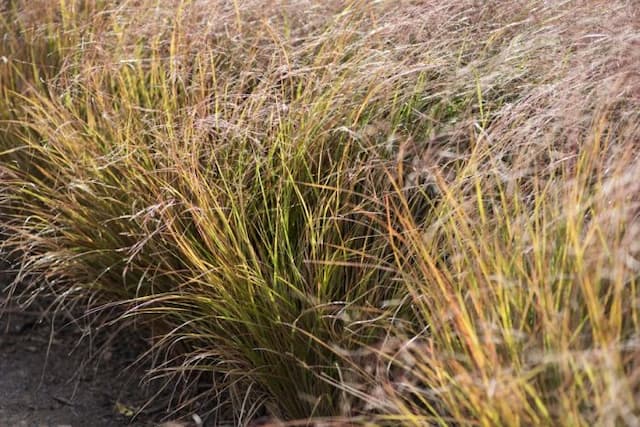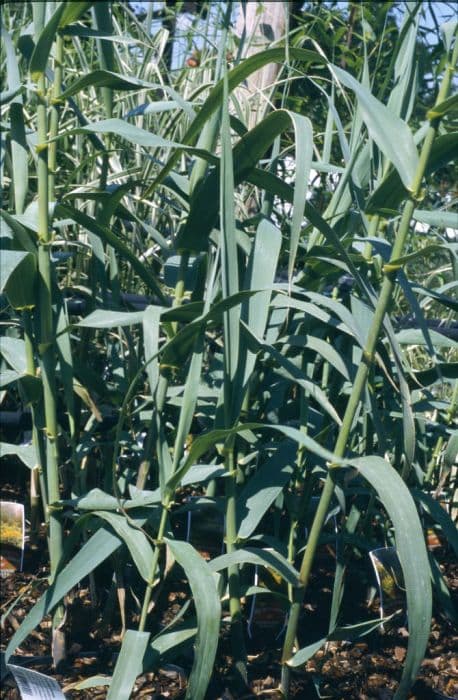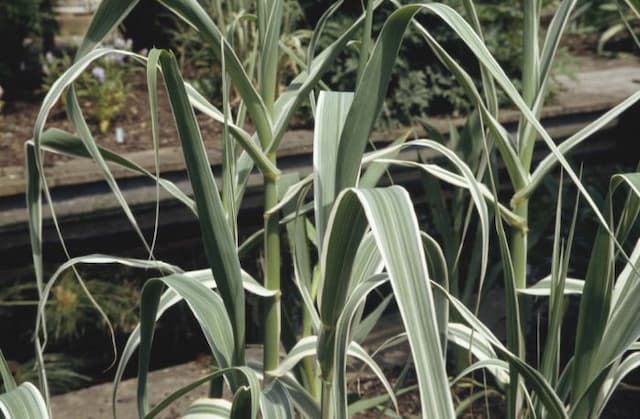Amethyst fescue Festuca amethystina

ABOUT
Festuca amethystina, commonly known as tufted fescue, presents a clump-forming appearance, displaying a dense tussock of grass with fine-textured, needle-like leaves. The foliage typically showcases a striking bluish-green color during the growth season, which can turn to a more brownish hue as the seasons transition. Come flowering time, tufted fescue produces slender, upright stems topped with airy, purple-tinged flower heads. These inflorescences add an ethereal, misty quality to the plant's profile, particularly when backlit by the sun. The delicate flowers can give the impression of a soft purple haze hovering over the fine foliage, creating a visually appealing contrast. Both the leaves and the flower spikes exhibit a fine, feathery texture that can sway gracefully in the breeze, adding a dynamic and textural element to garden spaces or naturalistic landscapes. Overall, tufted fescue's appearance is characterized by its fine foliage, subtle color transitions, and the soft, feathery quality of its flower heads.
About this plant
 Names
NamesFamily
Poaceae
Synonyms
Amethyst Fescue, Tufted Fescue
Common names
Festuca rubra subsp. amethystina (L.) Nyman, Festuca rubra var. amethystina (L.) Hack.
 Toxicity
ToxicityTo humans
Festuca amethystina, commonly known as tufted fescue, generally isn't considered toxic to humans. There is limited information suggesting any substantive toxic effects from ingestion of this plant by humans. As with any plant material, individual allergic reactions or sensitivities can occur, but standard references do not indicate intrinsic poisonous qualities for this species that would lead to symptoms of poisoning.
To pets
Tufted fescue is not known to be toxic to pets. It is not listed among plants that are typically hazardous to dogs, cats, or other domestic animals. That being said, ingestion of any non-dietary plant material can potentially cause mild stomach upset or an intestinal blockage, especially if consumed in large amounts. However, specifically regarding toxicity, tufted fescue does not appear to have components that are harmful to pets.
 Characteristics
CharacteristicsLife cycle
Perennials
Foliage type
Evergreen
Color of leaves
Blue-green
Flower color
Varies
Height
1-2 feet (30-60 cm)
Spread
1 foot (30 cm)
Plant type
Herb
Hardiness zones
4
Native area
Europe
Benefits
 General Benefits
General Benefits- Erosion control: Festuca amethystina, commonly known as tufted fescue, has a dense root system that helps in stabilizing the soil and preventing erosion.
- Drought tolerance: It is highly tolerant to drought conditions, making it suitable for dry and arid climates.
- Low maintenance: Tufted fescue requires minimal upkeep, making it ideal for those seeking a low-maintenance landscaping grass.
- Aesthetic appeal: Its fine texture and bluish-green to purple hues add visual interest to gardens and landscapes.
- Cold hardiness: The plant is resistant to cold temperatures, which allows it to thrive in cooler climates and higher altitudes.
- Wildlife habitat: It provides cover and habitat for small animals and insects, promoting biodiversity.
- Ornamental uses: Due to its attractive appearance, it is often used in ornamental gardens and public spaces.
- Soil improvement: The root system of Festuca amethystina can help improve soil structure over time.
- Adaptability: It can adapt to a wide range of soil types, from sandy to clay soils.
 Medical Properties
Medical PropertiesThis plant is not used for medical purposes.
 Air-purifying Qualities
Air-purifying QualitiesThis plant is not specifically known for air purifying qualities.
 Other Uses
Other Uses- Festuca amethystina, commonly known as Amethyst Fescue, can be used for soil stabilization and erosion control on sloped terrains due to its dense root system.
- In landscape design, Amethyst Fescue provides a striking purple hue that contrasts well with green and silver foliage plants.
- Due to its compact size and texture, it can be used in rock gardens to add variety and color variation among the stones and other alpine plants.
- Amethyst Fescue is suitable for xeriscaping, a landscaping approach that reduces or eliminates the need for irrigation.
- Its drought tolerance makes it an option for use in rain gardens that occasionally dry out, contributing to the filtration of runoff water.
- It can be planted in green roofs for urban buildings to enhance the thermal insulation and reduce the urban heat island effect.
- Amethyst Fescue's ornamental value is exploited in floral arrangements and decorative bouquets, particularly when dried.
- It provides a habitat for beneficial insects and small wildlife, promoting biodiversity in garden ecosystems.
- Due to its low growth habit, it can be utilized as living mulch under taller plants, helping to retain soil moisture and suppress weed growth.
- Amethyst Fescue can be used in educational settings, such as botanic gardens and horticultural programs, to teach about drought-resistant plants and ornamental grass care.
Interesting Facts
 Feng Shui
Feng ShuiThe plant Amethyst Deceiver is not used in Feng Shui practice.
 Zodiac Sign Compitability
Zodiac Sign CompitabilityThe plant Amethyst Deceiver is not used in astrology practice.
 Plant Symbolism
Plant Symbolism- Persistence: Festuca amethystina, commonly known as tufted fescue, often grows in tough, rocky environments, symbolizing the ability to persist through challenging conditions.
- Resistance: The hardy nature of tufted fescue represents durability and resistance, an emblem for withstanding adversity.
- Self-Sufficiency: Tufted fescue's adaptability to various soils and climates symbolizes independence and the capability to thrive with minimal care.
- Peaceful Solitude: Often found standing alone in its habitat, tufted fescue can represent the beauty and peace found in solitude.
 Water
WaterTufted Hair Grass should be watered moderately, generally once a week during its growing season. The soil should be allowed to dry out slightly between waterings to prevent root rot. Depending on weather conditions, this might amount to about 1 to 1.5 gallons per week for an established plant in moderate climates. Increase water during hot, dry periods and decrease during cooler, rainy spells to maintain consistent soil moisture without overwatering.
 Light
LightTufted Hair Grass prefers full sun to partial shade conditions. An ideal spot would receive direct sunlight for at least six hours a day, though it can tolerate some light shade, especially during the hottest part of the day. Avoid deeply shaded locations, as this can affect the plant's growth and foliage color.
 Temperature
TemperatureTufted Hair Grass thrives in a wide temperature range, withstanding temperatures as low as 0°F and as high as 80°F. It is hardy and can survive occasional dips below this range, but prolonged exposure to extremes can be harmful. The ideal temperature for robust growth is between 50°F and 75°F.
 Pruning
PruningPruning Tufted Hair Grass is important for maintaining its attractive shape and encouraging new growth. Cut back the foliage to a few inches above the ground in late winter or early spring before new growth starts. This yearly pruning helps remove old, dead material and stimulates the plant to produce fresh, vibrant leaves.
 Cleaning
CleaningAs needed
 Soil
SoilAmethyst tufted fescue prefers well-draining soil with a slightly acidic to neutral pH of 6.0 to 7.0. A good mix would be equal parts garden soil, coarse sand, and peat or compost to increase fertility and improve drainage.
 Repotting
RepottingAmethyst tufted fescue does not require frequent repotting and can be done every 2-3 years, or when it outgrows its current container to maintain its health and vigor.
 Humidity & Misting
Humidity & MistingAmethyst tufted fescue thrives in moderate humidity conditions and does not tolerate extremely high humidity levels well, making it suitable for average home environments.
 Suitable locations
Suitable locationsIndoor
Provide bright light and good air circulation.
Outdoor
Plant in full sun to part shade in well-drained soil.
Hardiness zone
4-8 USDA
 Life cycle
Life cycleFestuca amethystina, commonly known as Amethyst Fescue, begins its life cycle as a seed, which germinates in cool, moist soil typically during spring or autumn. After germination, the seedling establishes a root system and shoots that will develop into a tufted, perennial bunchgrass. As the plant matures, it produces narrow, fine-textured, blue-green leaves which form dense tufts or clumps. Throughout the growing season, it sends up tall flowering stems, bearing purplish or bluish-green inflorescences which are attractive and give the plant its amethyst-like appearance. Once pollinated, these flowers produce seeds, completing the reproductive cycle. The plant then enters a period of dormancy during cold winter months, resuming growth with the return of favorable temperatures and moisture levels in the environment.
 Propogation
PropogationPropogation time
Spring to summer
Propogation: When it comes to propagating Festuca amethystina, commonly known as amethyst fescue, the most popular method is through seed sowing. The best time for sowing is typically in the spring, as temperatures start to warm, ensuring that the soil is conducive to seed germination. For successful growth, seeds should be sown on the surface of a well-drained seed starting mix, lightly covered with soil, and kept consistently moist but not waterlogged. They require ample sunlight for germination, so placing them in a spot that receives lots of light is important. Germination can take anywhere from 14 to 21 days, after which the grass can be transplanted to its final location once it's big enough to handle and the risk of frost has passed.









